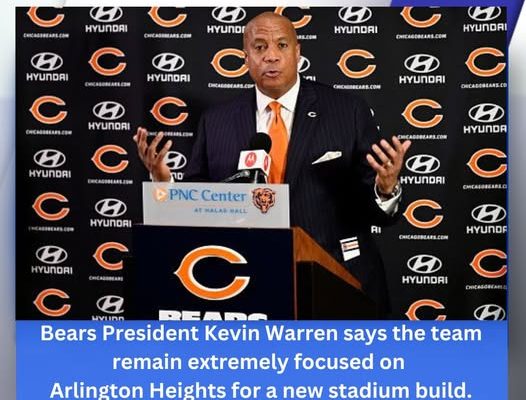The Chicago Bears have put a firm stamp on their intentions for the franchise’s next chapter, and it comes directly from the top. At a news conference Friday, team president Kevin Warren made it abundantly clear that despite months of speculation, rumors, and shifting narratives about where the team might eventually play its home games, Arlington Heights remains the centerpiece of the organization’s vision for the future. It was a statement that carried both weight and finality, delivered with the conviction of a leader determined to set the record straight amid the noise. While many had wondered if recent developments might open the door for a pivot back toward Soldier Field or even a different suburban site, Warren’s message was unmistakable—Arlington Heights is the plan, and the Bears are not wavering.
This declaration comes after a period of uncertainty in which various stakeholders, from fans to city officials to real estate developers, speculated about what might happen next. The Bears’ purchase of the Arlington Park property in 2023 was a massive step forward in their relocation journey, but lingering questions about property taxes, infrastructure costs, and public financing had left room for doubt. For months, the conversation in sports and business circles centered on whether the team might hedge its bets, exploring multiple site options simultaneously. The Friday press conference seemed to be Warren’s opportunity to draw a line in the sand. “We remain committed to Arlington Heights,” he said firmly, reinforcing that the organization’s resources, time, and strategic energy are aligned toward turning the former racetrack into a state-of-the-art NFL complex.
What makes this statement particularly significant is that it was not couched in the usual corporate hedging or vague promises that sometimes accompany stadium negotiations. Warren’s words were definitive, signaling to both the NFL and the public that the Bears are ready to stake their future in Arlington Heights. This is not just about building a stadium—it’s about creating a multi-use sports and entertainment district that could fundamentally reshape the Chicago Bears brand for the next century. While Soldier Field has been the franchise’s iconic home for decades, it has long been criticized for its limited seating capacity, lack of modern amenities compared to other NFL venues, and logistical challenges for both players and fans. Arlington Heights offers the space and flexibility to address all those concerns, as well as the potential to turn game days into all-day events with restaurants, shops, and fan experiences surrounding the stadium.
From a business standpoint, the benefits of committing to Arlington Heights are obvious. The Bears would have full control over their venue rather than being tenants of a city-owned stadium. This opens the door to revenue streams beyond football, including concerts, conventions, and other sporting events. The scale of the property allows for massive parking capacity, dedicated tailgating areas, and the possibility of developing residential and commercial spaces around the stadium to drive year-round economic activity. For the organization, that translates into both financial independence and the ability to curate the fan experience in ways Soldier Field simply cannot offer.
However, such a large-scale move also comes with challenges, and Warren’s comments suggest that the Bears leadership is well aware of them. The biggest hurdle so far has been the debate over property taxes and how much the team should pay relative to local school districts and municipalities. While Warren did not dive deeply into those details during the press conference, his tone indicated confidence that the organization and local governments will find a resolution. He emphasized collaboration, noting that building a project of this magnitude requires not only the Bears’ investment but also the support and alignment of public officials and community members. The commitment to Arlington Heights is not just a matter of geography—it’s a long-term partnership with the region.
This announcement is also a signal to fans, many of whom have been divided over the move. While some Chicago loyalists have mourned the idea of leaving the city limits, others have embraced the vision of a cutting-edge suburban complex. Warren’s direct approach Friday may help to ease some of that tension by removing the uncertainty. When fans know exactly where the team is headed, they can start imagining and getting excited about what the future holds, rather than being caught in limbo. For those concerned about losing touch with the Bears’ Chicago identity, Warren reiterated the franchise’s deep connection to its history and fan base. The team name will remain the Chicago Bears, and the organization intends to ensure that traditions, community outreach, and city-based events continue, even if home games are played in Arlington Heights.
From a league perspective, Warren’s comments come at a pivotal moment for stadium development in the NFL. In recent years, we’ve seen a wave of teams investing in high-tech, entertainment-driven stadiums designed to host everything from NFL games to global music tours and major sporting events like the Super Bowl or World Cup. Arlington Heights fits that mold perfectly. If done right, it could become one of the premier sports destinations in the country, attracting national and international attention. This is not only about meeting the needs of today’s fans but also about ensuring the Bears remain competitive in the NFL’s revenue and branding race for decades to come.
The press conference also indirectly addressed the competitive aspect of stadium economics. Neighboring teams like the Minnesota Vikings, with U.S. Bank Stadium, and the Los Angeles Rams, with SoFi Stadium, have set new benchmarks for what an NFL facility can be. If the Bears want to keep pace, they need more than incremental upgrades—they need a transformative venue. Arlington Heights provides that blank canvas, and Warren’s commitment suggests the organization is ready to paint the most ambitious picture possible.
Still, there is an emotional dimension to the move that cannot be ignored. Soldier Field has been synonymous with the Bears for generations. The icy winds coming off Lake Michigan, the unique colonnades, and the rich history of legendary players have given it a soul that can’t be replicated by architecture alone. Warren’s challenge will be ensuring that the new stadium doesn’t feel sterile or disconnected from the franchise’s legacy. His remarks hinted at this awareness, with references to honoring Bears history and creating spaces within the new complex that celebrate the team’s storied past. For many fans, that bridge between tradition and innovation will be key to embracing the Arlington Heights project fully.
In practical terms, Warren’s Friday statement likely also serves as a message to potential partners, investors, and the NFL itself. Clear public commitment can speed up negotiations, help secure sponsorships, and attract development partners eager to be part of a project with certainty rather than speculation. The Bears’ leadership knows that mixed signals can stall momentum. By planting their flag firmly in Arlington Heights, they are signaling to all involved parties that now is the time to move forward with planning, design, and eventually construction.
The next steps will be critical. While the vision is compelling, the execution will determine whether this project becomes a model for NFL franchises or a cautionary tale. Financing agreements, construction timelines, and community integration plans all have to align. Given the scale of the endeavor, it will likely be years before the first game is played there, but Friday’s press conference was a clear indication that the Bears are ready to accelerate the process.
For the fans, Friday’s announcement may have been the clearest roadmap they’ve heard yet for the team’s future. Whether they live in the city or the suburbs, whether they’re nostalgic for Soldier Field or eager for a new beginning, they now know where the Bears are headed. And for Kevin Warren, a leader whose tenure has already been marked by a willingness to tackle big, complex challenges head-on, this was a moment to showcase decisiveness and vision. Arlington Heights is not just an option—it’s the destination.
If history is any guide, the journey from press conference to ribbon-cutting will have its twists and turns. But one thing is certain after Friday: the Chicago Bears are thinking big, and they’re thinking in Arlington Heights. Warren’s remarks were not just about real estate—they were about ambition, identity, and the future of one of the NFL’s most storied franchises. And now that the focus is set, the clock has officially started on bringing that future to life.



